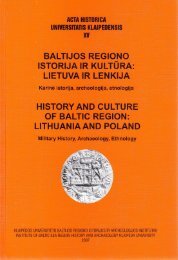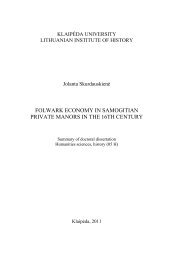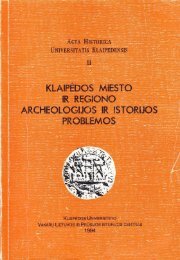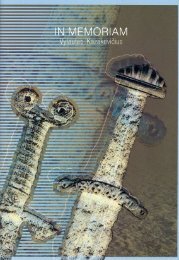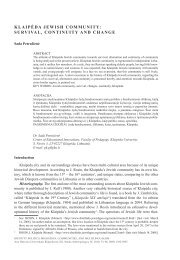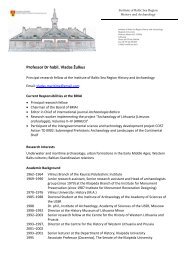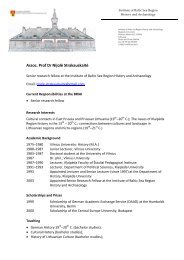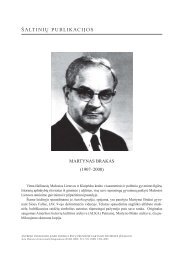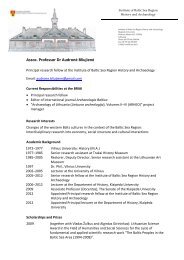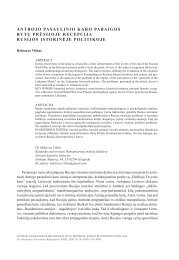university of klaipėda lithuanian institute of history roman širouchov ...
university of klaipėda lithuanian institute of history roman širouchov ...
university of klaipėda lithuanian institute of history roman širouchov ...
Create successful ePaper yourself
Turn your PDF publications into a flip-book with our unique Google optimized e-Paper software.
26<br />
For example, at the cemeteries <strong>of</strong> Southern Curonians female<br />
graves with typical sets <strong>of</strong> ornaments and other specific grave goods<br />
compiles on average 18-20% from all graves number (up to 58% at<br />
Pryšmančiai cemetery). As for Prussians, whose single layer cremations<br />
most <strong>of</strong> which could belong to women were found at average from 5 to<br />
15% (max - 37.7% - in Povarovka cemetery). Most <strong>of</strong> these graves are<br />
not noticeable for their special female grave goods. Another part <strong>of</strong><br />
supposed Prussian women cremations might be erected together with<br />
male double layer cremations, as the graves <strong>of</strong> dependent women. This<br />
is reflected by several double cremation graves <strong>of</strong> Holmy and Klin-<br />
covka-1 cemeteries.<br />
Judging by Prussian and Curonian single layer female crema-<br />
tions, their structure and stratigraphy, as well as by the data <strong>of</strong> the 13 th -<br />
14 th written sources a woman position in the Prussian and Curonian<br />
societies was similar - there were both free women as wives and de-<br />
pendent – as there were slaves too.<br />
Talking about V. Kulakov’s theory concerning Curonian female<br />
cremation graves occurred in Sambian peninsula, which is based on an<br />
analysis <strong>of</strong> several single layer cremations <strong>of</strong> Klincovka-1 cemetery,<br />
there should be noticed, that both grave goods <strong>of</strong> single layer crema-<br />
tions like Klincovka-1 Nr.62 or 80 and their stratigraphy are not the<br />
most typical for South Curonian female cremations <strong>of</strong> the 11 th -12 th<br />
centuries, known from such cemeteries as Bandužiai, Laiviai and<br />
Palanga. Perhaps such single layer cremations could belong to the<br />
“long lost” Prussian female graves, still known in extremely small<br />
number.



